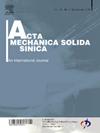Nickel-based alloys are the primary structural materials in steam generators of high-temperature gas reactors. To understand the irradiation effect of nickel-based alloys, it is necessary to examine dislocation movement and its interaction with irradiation defects at the microscale. Hardening due to voids and Ni3Al precipitates may significantly impact irradiation damage in nickel-based alloys. This paper employs the molecular dynamics method to analyze the interaction between edge dislocations and irradiation defects (void and Ni3Al precipitates) in face-centered cubic nickel. The effects of temperature and defect size on the interaction are also explored. The results show that the interaction process of the edge dislocation and irradiation defects can be divided into four stages: dislocation free slip, dislocation attracted, dislocation pinned, and dislocation unpinned. Interaction modes include the formation of stair-rod dislocations and the climbing of extended dislocation bundles for voids, as well as the generation of stair-rod dislocation and dislocation shear for precipitates. Besides, the interactions of edge dislocations with voids and Ni3Al precipitates are strongly influenced by temperature and defect size.


